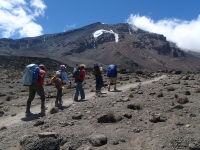
Kilimanjaro is the highest free standing mountain in the world and regarded as the highest mountain conquerable by someone with no formal training or experience in climbing. Children as young as 12 have made it to the highest point, Uhuru Peak (19,341 feet) and about 65 percent of the 35,000 hikers attempting the mountain annually make it to the top. Summiting Kilimanjaro, however, is not a venture to take lightly. The journey entails at least five days of near constant walking, weathering wind, ice, heat and a rapid change in altitude. A certain degree of fitness and the go-ahead from a doctor are strongly recommended before attempting this arduous, though ultimately rewarding, task.The climb in itself is not only a physical experience but an adventurous journey. You will have to brave Kilimanjaro's five ecological zones on your route to the top. First is the cultivated farmland, the slightly populated mountainside grazing area where locals herd their livestock. The second zone is the rich rainforest area, which boasts scenic rapids, assorted exotic greenery and monkeys by the dozen. Leopard, civet cats and several antelope might also be spotted if you keep your eyes open. In the third zone, the moors, you will encounter less wildlife but an abundance of odd low-lying vegetation, some of which is endemic to the mountain. The next zone, the alpine desert, is nearly pure desert with sub-zero temperatures at night and sweltering heat by day. These extreme fluctuations are represented in the presence of both rocky and icy fields within the same plain. Finally comes the summit itself, where the ascent becomes as steep as it gets and the oxygen supply is half what it was at sea level. The views from the top, however, are among the best Africa has to offer.There are six routes to the top of Kilimanjaro, not all of which end on Uhuru, and potential climbers should carefully consider their preferences before deciding on the trip. Several tour operators work on the mountain and they will map your route, guide you and carry your luggage - so compare prices and routes carefully before booking your Kilimanjaro experience.

Tanzania boasts outstanding opportunities for viewing wildlife in its natural habitat and offers some of the finest game viewing on the continent. A vast amount of the country is protected within parks and reserves and of these the vast open plains of the Serengeti, famous for the annual migration of millions of animals, is the most well-known. Africa's Eden, the unique Ngorongoro Crater, is another popular safari destination.The word 'safari' actually has its origins in Tanzania, which should give travellers some idea of the region's game viewing prestige. Safari is a Swahili word meaning 'journey', and there are unlimited safari options in Tanzania that can be tailor-made by any number of capable and well-established tour operators, with accommodation ranging from luxury lodges to simple camping. A journey by vehicle, foot, horseback or hot air balloon into prime game-viewing country is an experience not to be missed.The best time of year to go on safari in Tanzania is generally between June and October, during the dry season, but there is some variation depending on region and desired activities. The Great Migration is best viewed in June and July in the Serengeti, but this famous national park is also special in January and February when it is calving season. The southern and western parks are at their best between June and October. The wet season in April and May is best avoided as road travel can become difficult and game viewing can be compromised.

Zanzibar offers an excellent combination of shallow water reefs around the surrounding offshore islands, ideal for beginners, and high walls, deep channels and shipwrecks for the more experienced. The best and most varied diving can be found along the northeastern coast around Mnemba Island, with beautiful coral gardens and wall dives. Stone Town has some interesting nearby wrecks and well-preserved coral reefs. Mafia Island, just south of Zanzibar and also part of the Spice Islands and Tanzania, is also a great scuba diving destination.Scuba diving is possible in this region all year round, with warm weather and warm water. The most popular seasons for diving are between July and September and December and January, but this has more to do with popular tourist seasons than dive conditions. Other good times to dive are in February and March, when animal life is plentiful, and in October, when the ocean is at its calmest. Around March the giant but gentle whale sharks stop here on their migration and meeting these majestic creatures often proves to be the highlight of a dive of these islands. April and May should perhaps be avoided by serious scuba divers as this is the rainy season and visibility is reduced.Zanzibar is a comparatively safe and comfortable diving destination, with gentle currents, perpetually warm water and good visibility most of the year. There are dive schools affiliated to many big hotels in Zanzibar, and they are numerous in Stone Town and Matemwe, making arranging a dive and getting equipment easy.

The wildebeest migration which takes place between Kenya's Masai Mara and Tanzania's Serengeti National Park is celebrated as the greatest natural show on earth and is a bucket-list experience for lovers of wildlife. Twice a year over two million animals, including hundreds of thousands of wildebeest, zebra, Thomson's gazelle and buffalo, migrate in search of greener pastures. The herds of herbivores move in giant groups, making the Great Migration a sort of buffet for the predators of the region, with animals like lions, cheetahs, wild dogs and crocodiles on the hunt, often picking on the young or weak animals that bring up the rear. River crossings are particularly dramatic to witness as the huge herds stampede through the water, wary of crocodiles trying to make a catch.The best time to experience this migration is between June and August when the wildebeest cross the Grumeti and Mara rivers with their attendant hungry crocodiles. The exact dates of the migration change from year to year, and the herds spend a few months in the Masai Mara before gradually heading back to the Serengeti in December and January. Most tourists watch the show from a four-wheel drive vehicle but other exciting options include riding alongside the wildebeest on a horseback safari or hovering above in a hot air balloon.

Travel Guide powered by Word Travels, copyright © 2023 Globe Media Ltd. By its very nature information in this travel guide is subject to change at short notice and travellers are urged to verify information on which they're relying with the relevant authorities. Neither Globe Media Ltd nor Travel Vogue can accept any responsibility for any loss or inconvenience to any person as a result of information contained above.